Faizabad
| Faizabad फ़ैज़ाबाद فیض آباد | |
|---|---|
| City | |
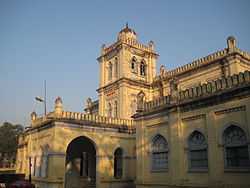 | |
 Faizabad | |
| Coordinates: 26°47′N 82°08′E / 26.78°N 82.13°ECoordinates: 26°47′N 82°08′E / 26.78°N 82.13°E | |
| Country |
|
| State | Uttar Pradesh |
| District | Saket |
| Area | |
| • Total | 88 km2 (34 sq mi) |
| Elevation | 97 m (318 ft) |
| Population (2011) | |
| • Total | 510,000 |
| • Density | 5,800/km2 (15,000/sq mi) |
| Languages | |
| • Official | Hindi, Urdu |
| Time zone | IST (UTC+5:30) |
| PIN | 224001 |
| Telephone code | 05278 |
| Vehicle registration | UP 42 |
| Sex ratio | 898/1000 ♂/♀ |
| Website | faizabad.nic.in |
City of Saket Faizabad (Hindi: फ़ैज़ाबाद, Urdu: فیض آباد, Old British Colonial: Fyzabad), the old capital of Awadh, is the headquarters of Faizabad District and Faizabad division as well. Its a joint municipal board with Ayodhya in the state of Uttar Pradesh, India, situated on the banks of river Ghaghra (locally known as Saryu). It was the first capital of the Nawabs of Awadh and has monuments built by the Nawabs, like the Tomb of Bahu Begum, Gulab Bari etc. The Legend of Awadh, Umrao Jaan 'Ada', was born in Faizabad (her childhood name was Ameeran). Another legend and Hindi writer Radhika Prasad Tripathi was from this city. Akhtaribai Faizabadi, also known as Begum Akhtar, was born in Faizabad. She was a classical singer who performed Urdu ghazals, dadras, thumris, etc. Among other notable people from Faizabad are Mir Babar Ali Anis, a nineteenth-century writer of Marsiya (elegies in Urdu) and Brij Narayan Chakbast, another nineteenth-century Urdu poet. Chakbast is credited to have translated the Ramayana into Urdu for the first time.
History
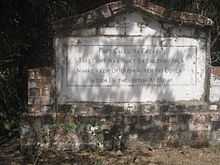


The earliest reference made to Saket Faizabad is said to be in the Ramayana, in which the city is referred to as Saket, the mythical private estate of King Dashrath, father of Lord Ram but the other sources indicate that Saket, which means Heaven in Sanskrit, is the ancient name of holy city of Ayodhya not Faizabad. However, more accurately, the reference is found in Medieval and Modern history, when Nawab Saadat Ali Khan, Burhan-ul-Mulk was given the charge of the Subah of Awadh around 1722 by the Mughal Court. Nawab Sa'adat Khan made the first settlements along the banks of Ghaghra with a cantonment consisting of a fortress and mud barracks. Due to these temporary dwellings, Faizabad was first known as 'Bangla' (implied meaning- hutment).
Establishment of Princely state of Avadh
Avadh, a princely state of India, was established around 1722 AD with Faizabad as its capital and Saadat Ali Khan I as first Nawab and progenitor of Nawabs of Awadh He made his own palace near Ayodhya, and renamed the city od Saket to Faizabad, which became the capital of the new government. Due to his management policy state's income rose from Rs.7 to 20 million.[1]
Faizabad was developed later on by Saadat Ali Khan's second successor, Nawab Shuja-ud-Daula into a full fledged capital city, with gardens, palaces, markets, roads and other infrastructure. Under Shuja-ud-Daula's reign Faizabad achieved its culmination as an important centre of trade and commerce in northern India and attracted travellers, writers, merchants, artists and courtesans from all over Europe and Asia. Shuja-ud-Daula also built a fortress on the banks of Saryu after he lost the battle of Buxar in 1764. however, this fort now is nothing more than a hummock, just an edict remains which is pictured here.
Faizabad was also a centre of one of many battles of the Mutiny of 1857. A detailed history of Faizabad can be read in 'Tareekh-e-Farahbaksh', written by Munshi Mohd. Faiz Baksh, (after whom Faizabad is named) a courtier in the Shuja-ud-Daula's court. This book has been translated into English by Hamid Afaq Qureshi as 'Memoirs of Faizabad'. Faizabad also finds a prominent and detailed mention in 'Guzishta Lakhnau' written by Maulvi Abdul Halim 'Sharar'. The third nawab of Awadh, Nawab Asaf-ud-Daula, shifted the Capital of Avadh to Lucknow in 1775 after his terms with his mother became sour.[2]
Saadat Khan, the first Nawab of Awadh, laid the foundation of Faizabad at the outskirt of ancient city of Ayodhya. Faizabad developed as a township during the reign of Safdar Jang, the second nawab of Avadh (1739–54), who made it his military headquarters while his successor Shuja-ud-daula made it full fledged capital city. Suja-ud-daula, the third Nawab of Awadh, settled at Faizabad after 1764 and built a fort known as Chhota Calcutta, now in ruins. In 1765 he built the Chowk and Tirpaulia and subsequently laid out the Anguribagh and Motibagh to the south of it, Asafbagh and Bulandbagh to the west of the city. During the reign of Shuja-Ud-Daula, Faizabad attained such a prosperity which it never saw again. The Nawabs graced Faziabad with several beautiful buildings, notable among them being the Gulab Bari, Moti Mahal and the tomb of Bahu Begum. Gulab Bari is a striking building of fine properties, standing in a garden surrounded by a wall, approachable through two large gateways. These buildings are particularly interesting for their assimilative architectural styles. Shuja-ud-daula's wife was the well known Bahu Begum, who married the Nawab in 1743 and continued to reside in Faizabad, her residence being the Moti-Mahal. Close by at Jawaharbagh lies her Maqbara, where she was buried after her death in 1816. It is considered to be one of the finest buildings of its kind in Avadh, which was built at the cost of three lakh rupees by her chief advisor Darab Ali Khan. A fine view of the city is obtainable from top of the begum's tomb. Bahu Begum was a woman of great distinction and rank, bearing dignity. Most of the Muslim buildings of Faizabad are attributed to her. From the date of Bahu Begum's death in 1815 till the annexation of Avadh, the city of Faizabad gradually fell into decay. The glory of Faizabad finally eclipsed with the shifting of capital from Faizabad to Lucknow by Nawab Asaf-ud-daula.[3]
Connection of freedom fighters with Faizabad
.jpg)
Ashfaqulla Khan was detained in the Faizabad jail. A case was filed against him. His brother Riyasat Ulla Khan deployed Kripa Shankar Hajela, a senior advocate to plea his case as a counsellor. Mr Hajela fought the case till the very end but he could not save his life. While in jail, Ashfaq daily performed five times Islamic prayer ('Namaj'). The case of the Kakori conspiracy was concluded by awarding death sentence to four daredevils viz. Pandit Ram Prasad Bismil, Ashfaqulla Khan, Rajendra Lahiri and Thakur Roshan Singh. The sixteen others were awarded the rigorous punishment varying from four years up to life sentence.
A section of people believe that the prominent Indian freedom fighter and revolutionary, Subhas Chandra Bose spent his last days in Faizabad living incognito as a godman called 'Gumnami Baba'. This came under attention when 'Gumnami Baba' died in 1985 and was cremated secretively on the banks of river Saryu (a memorial has been built at that place), in the dead of night, in the light of a motorcycle's headlight. Its also said that at the time of cremation his face was disfigured by acid to protect his identity. However, no government enquiry was launched into this matter and the identity of Gumnami Baba still remains an enigma.
Demographics
As per provisional reports of Census India, population of Faizabad in 2011 is 167,544; of which male and female are 87,279 and 80,265 respectively. The sex ratio of Faizabad city is 920 per 1000 males. In education section, total literates in Faizabad city are 130,700 of which 70,243 are males while 60,457 are females. Average literacy rate of Faizabad city is 86.52 percent of which male and female literacy was 89.34 and 83.45 percent. Total children (0–6) in Faizabad city are 16,479 as per figure from Census India report on 2011. There were 8,658 boys while 7,821 are girls. Child sex ratio of girls is 903 per 1000 boys. Faizabad city is governed by Municipal Corporation which comes under Faizabad Urban Agglomeration. Although Faizabad city has population of 167,544; its urban / metropolitan population is 259,160 of which 139,074 are males and 120,086 are females.
Geography
Climate
| Climate data for Faizabad | |||||||||||||
|---|---|---|---|---|---|---|---|---|---|---|---|---|---|
| Month | Jan | Feb | Mar | Apr | May | Jun | Jul | Aug | Sep | Oct | Nov | Dec | Year |
| Record high °C (°F) | 28 (82) |
32 (90) |
41 (106) |
44 (111) |
46 (115) |
48 (118) |
41 (106) |
38 (100) |
38 (100) |
37 (99) |
33 (91) |
28 (82) |
48 (118) |
| Average high °C (°F) | 18 (64) |
26 (79) |
32 (90) |
36 (97) |
40 (104) |
42 (108) |
36 (97) |
34 (93) |
35 (95) |
32 (90) |
26 (79) |
20 (68) |
33 (91) |
| Average low °C (°F) | 6 (43) |
12 (54) |
16 (61) |
22 (72) |
27 (81) |
29 (84) |
27 (81) |
26 (79) |
25 (77) |
20 (68) |
12 (54) |
7 (45) |
15 (59) |
| Record low °C (°F) | −3 (27) |
7 (45) |
— | — | — | — | — | — | — | — | — | — | −3 (27) |
| Precipitation mm (inches) | 23 (0.91) |
16 (0.63) |
9 (0.35) |
5 (0.2) |
6 (0.24) |
68 (2.68) |
208 (8.19) |
286 (11.26) |
202 (7.95) |
43 (1.69) |
7 (0.28) |
8 (0.31) |
881 (34.69) |
| Source: [4] | |||||||||||||
Summer (March to July) temperatures can range from 35 to 45 degrees Celsius. Winters (November to January) temperatures can range from 6 to 25 degrees Celsius. Rains during monsoon season (July to September).
Transport
By Road
Faizabad is situated on National Highway 28 and has good connectivity with Kanpur(213 km), Lucknow (127 km), Varanasi (202 km), Allahabad (161 km) and Gorakhpur (165 km). The state government's Road Transport Service runs regular and frequent buses to and from these cities. NH28 connects Lucknow to Barauni via Faizabad and Gorakhpur whilst NH96 connects Faizabad to Allahabad via Sultanpur. Nawab Yusuf Road connects Faizabad to Varanasi via Jaunpur.
By Train
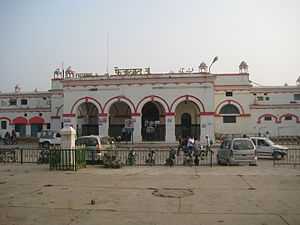
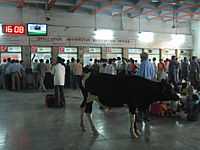
Faizabad Railway Station: The Indian Railways network connects Faizabad directly with Kanpur (4 hours) Lucknow (3 hours.), Varanasi (4 hours.) and Allahabad (5 hours). Direct trains such as Indore - Rajendra Nagar Via. Faizabad Express connects it with Indore, Ujjain, Bhopal Junction, Jhansi, Varanasi and Patna on weekly basis. A few mail express trains also connect Faizabad to Kolkata, New Delhi and Mumbai.
Ayodhya Junction: Ayodhya Junction is the second major railway station within the Faizabad city which is situated at south end of the city.
By Air
Nearest airports are Kanpur Airport(186 km) Lucknow International Airport (128 km), Allahabad Airport (144 km) and Varanasi International Airport (200 km)
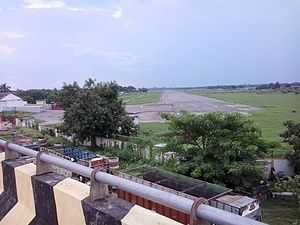
Faizabad has an old airport and flying school at naka along national highway (NH28). The airport has been neglected since a long time due to the lack of leadership and support. Recently, efforts are there to convert this airport into full fledged domestic airport by Union government. Union aviation minister Ajit Singh is constantly demanding this airport to be handed over to Airports Authority of India so that the airport could be developed further and scheduled domestic flights could be operable from this airport. But the lack of will and interest by state government is hindering and delaying the development of this airport.
Sports
Faizabad Sports Complex
Faizabad Sports Complex Loc: 26°43′47″N 82°08′17″E / 26.72972°N 82.13806°E is an international standard sports complex being built on NH 96 (Faizabad To Sultanpur Road). The new sports complex would have astro turf, synthetic track, olympic size swimming pool, cricket field, hostels and other required facilities. After an ultra-modern sports complex in Greater Noida, meerut and at Saifai in Etawah, this is one of the sports facilities in Uttar Pradesh.
Faizabad International Sports Stadium

Known as Bhim Rao Ambedkar International Sports Stadium is the part of multi crore Rs. project for sports complex by state government. The Lokayukta office has received a complaint from one Bhanu Pratap Singh of Faizabad who has accused the minister of corruption in the construction of Faizabd international stadium. According to the complainant, the sports minister had a nexus with former sports director Hari Om and former project manager R.D. Prasad and had deliberately delayed the construction of the ![]() 86 crore Dr Bhim Rao Ambedkar stadium, paving the way for an escalation of costs to
86 crore Dr Bhim Rao Ambedkar stadium, paving the way for an escalation of costs to ![]() 1.50 billion.[5][6]
1.50 billion.[5][6]
Citiscape
Places to see
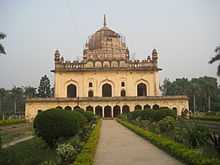
Gulab Bari: Literally meaning 'Garden of Roses', the tomb of Nawab Shuja-ud-Daula (third Nawab of Awadh), this place has a good collection of roses of various varieties set by the sides of water fountains. Gulab Bari also houses a maqbara (Mausoleum) of Nawab Shuja-ud-Daula in the campus.

Bahu Begum ka Maqbara: (The Mausoleum of the Queen Bride) the memorial built for queen of Nawab Shujah-ud-Daulah, Unmatuzzohra Bano Begum. Its one of the tallest buildings in Faizabad and is a beautiful example of non-mughal Muslim architecture. Sadly, this beautiful monument is a victim of neglect and is crumbling.
Military Temple: (The Dogra Regimental Centre/ Corps of Military Police CMP Temple) Located in cantonment area, this temple is beautifully built and the cleanlines and the pollution free environment is just spiritual thing.
. Guptar Ghat: the Ghat (Jetty) where Lord Rama is believed to have taken 'jal samadhi' (leaving the earth for 'Baikuntha', the divine abode of Lord Vishnu, by drowning himself). It has picturesque view of the saryu river and its green banks and has several ancient temples. The view of sunset from Guptar Ghat is breathtaking. a boat ride is a must while visiting this place.
Company Gardens : Adjoining Guptar Ghat, on the banks of River Saryu, is Company Gardens, a botanical garden built during British Rule. it has a well maintained, sprawling garden set amidst lush greenery, far away from the hustle and bustle of the town. It also has an orchard spread over acres. Plants and Trees can also be bought here. The remains of the fort built by Nawab Shuja-ud-Daula after the battle of Buxar is also within walking distance.
Ghanta Ghar: The heart of Faizabad city, houses a clock tower (Ghanta means 'clock' in Hindi and Ghar is the Hindi word for 'house') in the middle of the city center. All distances within the city are measured from this location. The place is also known as Chowk, which houses the main vegetable and spice market in the town.
Shringi Rishi Ashram: 35 km from Faizabad in Goshainganj is ashram of Sage (Rishi in Sanskrit/Hindi) Shringi. Shringi Rishi performed 'Putrakameshti Yajya' for King Dashrath of Ayodhya, after that Lord Rama and his three brothers were born. There is an ashram of Shringi Rishi situated at Sherwaghat near Mehbubganj 11 km from Goshainganj on the banks of Sarayu river at Sherwa Ghat. Legend has it that Shringi Rishi cursed King Parikshit for his sinful conduct against rishi Lomash. The boons and curse uttered by him were proved to be absolutely true. Rishi Shringi was a distinguished expert of the super science of mantras. A temple of Shringi Rishi, is also located at Sherwaghat, and a fair is held every year in May in his honour. A cave is also located in district Faizabad near Mehbubganj Near Goshainganj where he is supposed to have stayed. It is a long cave where he is supposed to do 'yagna' (Ritual) and is worth seeing. A place called Dilasigang. This is amazing place as located on Ghaghra bank River.
Shopping places

Faizabad Chowk: Next to Ghanta Ghar, is the central market of Faizabad town. One can find vegetables, fruits and spices, jewellery shops, clothing and other retail.
Rekabgunj: About a kilometer away from Chowk (towards Lucknow) lies the Rekabgunj market which has a multitude of pharmacies. The market also has some seed shops which cater to the farmers of the adjoining regions. Many Restaurants and Hotels are there when going towards Lucknow. This is one of the Tourist's spot.
Bajaja: (now known as Subhas Nagar)A place adjacent to Chowk towards Sultanpur Road holds a market for Clothes and garments. In Urdu Bajaja means cloth market. This area also holds major banks viz Union Bank of India, SBI and Allahabad Bank. Abha hotel in the centre of bajaja and in the main city.
Fatehganj: This is a market mainly for wholesale grocery and other house hold items. This area is on the same road on which Bajaja falls. Hotel Krishna Palace is adjacent to the fountain near Faizabad jail. This is the place which is near to Bus Station as well as Railway Station. This is one of the Tourist's spot.
Education
There are two Universities in Faizabad District, Dr.Ram Manohar Lohia Awadh University (formerly Avadh University) Awadh University and Narendra Dev University of Agriculture and Technology in Kumarganj Faizabad (NDUAT). Kamta Prasad Sundar Lal Saket Post-Graduate degree college, one of the finest PG college of Awadh university, is also situated in Ayodhya, Faizabad.[7]
Faizabad has a number of degree and post degree colleges and an array of English and Hindi medium schools which include Army Public School, JBA,tiny tots school, Udaya Public School, Anil Saraswati Vidya Mandir, Faizabad Public School, Government Inter College(G.I.C.), Canossa Convent Girls' Inter College, S.S.V. Inter College, H.C.J. Academy etc. government inter college
Namesakes
The Town of Fyzabad in Trinidad and Tobago is named after Faizabad, when indentured labourers from Faizabad and other districts in Uttar Pradesh were taken to the islands. There are towns with same name in Afghanistan (Fayzabad, Badakhshan) and Tajikistan (Faizobod) as well. Fayzabad in Afghanistan is the administrative headquarter of the Badakhshan Province. M M Luskhary Academy, Barun Bazar, Faizabad
Famous people
Among notable people from Faizabad are Mir Babar Ali Anis, a nineteenth-century writer of Marsiya (elegies in Urdu) and Brij Narayan Chakbast, another nineteenth-century Urdu poet. Chakbast is credited to have translated the Ramayana into Urdu for the first time.
- Mitrasen Yadav (Politician).
- Mangal Pandey ( Father of India's first war of Independence 1857, Born in Akbarpur tehsil)
- Mirza Rafi Sauda was born in Faizabad.
- Acharya Narendra Deva
- Arjun Award winner Boxer Akhil Kumar was born in Faizabad.
- Francis Quinton, an English cricketer, was born Faizabad.
- Rockstar Barry Hay a pop singer was born in Faizabad.
- Indu Jain (Owner of Bennett, Coleman & Co. Ltd,Times of India Group,Forbes India's top 20 richest person)
- Vinay Katiyar (Politician)
- Mir Babar Ali Anis a famous Urdu poet
- Brij Narayan Chakbast (Poet writer of URDU Ramayana)
- Umrao Jaan(a Famous character named Umrao Jaan Ada)
- Akhtari Bai Faizabadi, or Begum Akhtar
- Akhil Kumar ( Indian Boxer, Olympian)
- Pooja Batra (Blooywood actress)
- Deepal Shaw (Blooywood actress)
- Abhishek Chaubey (Director - Ishqiya,de ishquiya)
Faizabadi cuisine
Traditionally being an unintegrated part of Awadh; Awadhi cuisine is the cuisine popular in Faizabad.
-

Awadhi thali (platter) with Naan bread, Daal, Raita, Shahi paneer, and Salad.
-

Some assorted halva including sooji, chana, and gajar halva
-
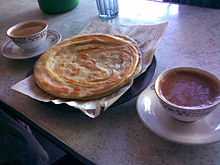
Paratha served with tea.
-

puri with accompaniments
-

Chicken Dum Biryani is one of the delicacy of Awadh.
-
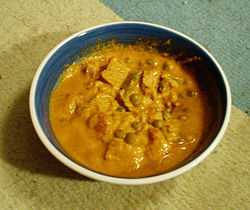
Navratan Korma
-

Persian dishes introduced in Awadh region.
-

Chicken Curry with Chapati.
Cooking style
Dum dena: This is a frequently method used in Awadh cooking. 'Dum' literally means 'breath' and the process involves placing the semi-cooked ingredients in a pot or deg, sealing the utensil with flour dough and applying very slow charcoal fire from top, by placing some live charcoal on the lid, and some below. The Persian influence is most evident in this method though in Awadh it has acquired its own distinct character. The magic of dum' is the excellent aroma, flavor and texture which results from slow cooking. This method is followed for a number of delicacies such as the Shabdeg, Pulao and Biryani. Any dish cooked by this method is 'Dum Pukht' or 'Dum Bakht'
Gallery
-
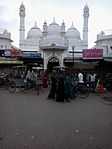
-
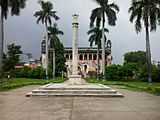
-

-

-

-
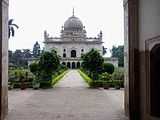
-
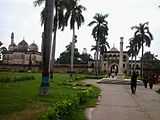
-

-
This temple is situated in the centre of Ayodhya, Faizabad and is visited by a number of travellers.
-

Bollywood actress Pooja Batra was born in Faizabad.
-
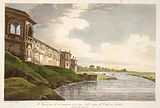
Depiction of The fort, now ruined, was built by Shujaudaula of Faizabad Hodges, William (1744–1797).
-
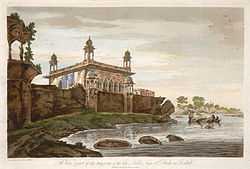
Depiction of Faizabad Fort by William Hodges, 1787.
-

Gate of the Loll-Baug at Fyzabad; by Thomas and William Daniell, 1801* (BL).
-
-

Rose Garden at Gulab Bari
-

Inside view of the Tomb
-
Hammam at the Gulab Bari
-
Entrance to Bahu Begum ka Maqbara.
-

"Gateway, Faizabad," a photo, c.1880's.
-
another view of Maqbara
-
Ramparts of Maqbara
-
The main entrance way of Maqbara is lined with palm trees.
-
The majestic architecture
-
Arched entrance to halls inside Maqbara.
-
-
A hall inside maqbara of bahu begum
-

Gulab Bari, The Mausoleum of Nawab Shuja ud Daulah,
-

The temple at Guptar Ghat
-

Guptar Ghat during the dry winter season
-

beautiful gothic style church at the Mission School
-
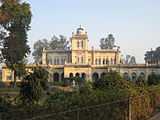
Tilak Hall, Faizabad's town hall, office of the municipal board. During the Raj, was known as "Victoria Memorial Hall"
-

Faizabad Chowk, the city centre with its clock tower.
-
Acharya Narendra Dev's family mansion in Faizabad.
-
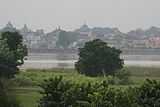
Ayodhya Ghaat on the bank Ghaghara river.
-

Acharya Narendra Deva's Family Mansion in Faizabad
-
Ghaghra river, locally known as Saryu, at Faizabad.
-
Ghaghara river Faizabd.
-
Famous Hanuman Garih temple. A Young Priest is operating the Darshan system.
-
This river is of ancient significance, finding mentions in the Vedas and the Ramayana. On Ram Navami, the festival that celebrates the birthday of Lord Rama, thousands of people take a dip in the Sarayu River at Ayodhya.
Surrounding districts
 |
Barabanki | Gonda | Gonda |  |
| Sultanpur | |
Basti | ||
| ||||
| | ||||
| Sultanpur | Ambedkar Nagar | Ambedkar Nagar |
See also
References
- ↑ "HISTORY OF AWADH (Oudh),a princely State of India". by Hameed Akhtar Siddiqui. Retrieved 2012-06-29.
- ↑ "History of Faizabad". myuttarpradesh.co.in/. Retrieved 2012-06-29.
- ↑ "Welcome to Faizabad History". official website of Faizabad district. Retrieved 2012-06-29.
- ↑ "Faizabad". Retrieved 25 March 2010.
- ↑ "Sports minister faces lokayukta probe in U.P.". Asian Age. Lucknow. 31 Oct 2011.
- ↑ "Ayodhya Prasad Pal comes under Lokayukta scanner for corruption charges". 30 October 2011.
- ↑ "K.S. Saket P.G.College, Ayodhya, Faizabad". Kssaket.org. Archived from the original on 6 October 2010. Retrieved 2012-06-29.
External links
| Wikimedia Commons has media related to Faizabad. |
| ||||||||
| |||||||||||||||||||||||||||||




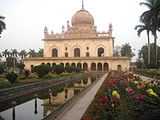

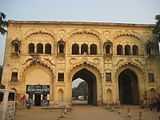

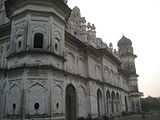


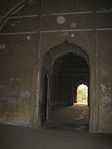
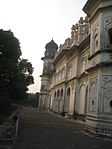
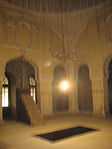

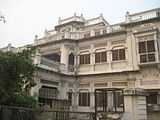

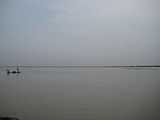
%2C_India.JPG)
%2C_India..JPG)